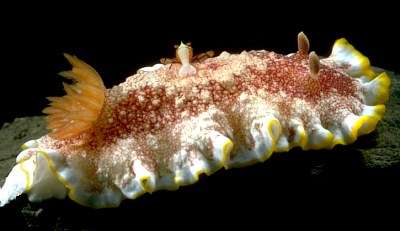
Chromodoris tinctoria
(Ruppell & Leuckart, 1828)
Order: NUDIBRANCHIA
Suborder: DORIDINA
Family: Chromodorididae
DISTRIBUTION
Throughout the tropical Indo-West Pacific.
PHOTO
UPPER: Passe du Baron, off Koumac, New Caledonia, 12m, in lagoon, October 1993, 3 specimens (75, 80 & 95mm long alive). This animal showing irregular white submarginal band. Note commensal shrimp Periclimenes on back.
LOWER LEFT: Fumba, Zanzibar, Tanzania, July 1971, showing absence of white submarginal band around mantle, except anteriorly.
LOWER RIGHT: A, Lizard Is, North Queensland, June 1979, showing regular white submarginal band. B, A second New Caledonian specimen showing red spots in white border region.
PHOTOS: Bill Rudman.
Although I initially thought (Rudman, 1973) there were differences between Doris tinctoria Ruppell & Leuckart, 1828, Doris reticulata Quoy & Gaimard, 1832, Goniobranchus reticulatus Pease, 1866, Chromodoris alderi Collingwood, 1881 and Chromodoris inopinata Bergh, 1905, extensive collections from throughout the Indo-West Pacific indicate that the species differences suggested by different colour patterns is not supported by internal anatomy. The earliest name for this species then is C. tinctoria. The main colour differences are found at the border of the mantle, which I have illustrated on this page. Usually there is an irregular white region between the yellow border and the red reticulate pattern which covers most of the mantle. In some animals this white region is absent or can occur just around the anterior end. In others the white region is a very regular white submarginal band, and in others small rounded patches of the reticulate pattern form red spots in the white region. Sometimes these spots are uniform red, but usually they have a red reticulate pattern.
Reference:
•Rudman, W.B. (1973) Chromodorid opisthobranch Mollusca from the Indo-West Pacific. Zoological Journal of the Linnean Society 52(3): 175-199.
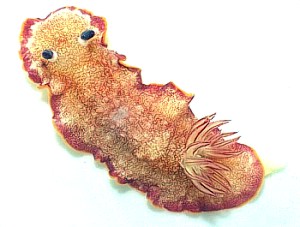
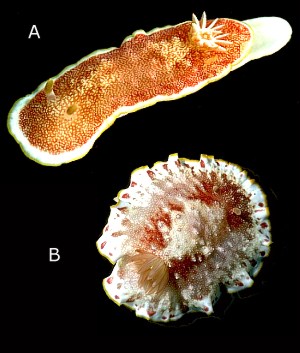
Rudman, W.B., 1999 (October 30) Chromodoris tinctoria (Ruppell & Leuckart, 1828) . [In] Sea Slug Forum. Australian Museum, Sydney. Available from http://www.seaslugforum.net/find/chrotinc
Related messages
Chromodoris tinctoria from Port Philip Bay, Victoria
November 25, 2009
From: Peter Eyre
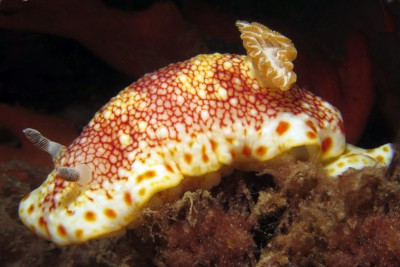
Hi Bill,
I took this photo of a fairly common nudibranch found under the Blairgowrie marina in Port Phillip Bay. It is commonly found on the sand but also numerous on the pylons of the marina. I've been told it goes under the common name of Meshed Chromodoris but is yet officially unnamed. Can you shine some light on this?
Locality: Blairgowrie, 5m, Victoria, Australia, Port Phillip Bay, 21 November 2009, sheltered sandy bottom. Length: 65 mm. Photographer: Peter Eyre.
Thanks
Peter
pete_eyre@yahoo.com
Eyre, P.J., 2009 (Nov 25) Chromodoris tinctoria from Port Philip Bay, Victoria. [Message in] Sea Slug Forum. Australian Museum, Sydney. Available from http://www.seaslugforum.net/find/22838Dear Peter,
This is Chromodoris tinctoria. It is found throughout the tropical Indo-West Pacific and is quite variable in colour pattern. Over the years a number of names have been proposed for various colour patterns but the patterns tend to merge into each other and certainly here is no geographical separation or obvious anatomical differences. This 'colour form' has been quite common in Western Australia and St Vincents Gulf in South Australia. I think its regular occurrence in Port Philip Bay is a fairly recent phenomenon - certainly Bob Burn didn't list it from there in 1989.
If you have photos of it feeding or aggregating on a particular sponge, or laying eggs, they woud be of great interest. In species or 'species groups' with variation like this, it is always possible that some biological observation - say different sized eggs or shape of egg ribbon or food sponge, will give us a clue to differences not immediately obvious from their anatomy.
This is one of an interesting tropical faunal element which appears to have colonised southern Australia from Western Australia rather than down the east coast, as records of C. tinctoria appear to be absent from southern New South Wales.
- Burn, R. F. (1989). Opisthobranchs (Subclass Opisthobranchia): Marine Invertebrates of Southern Australia, Part 2. S. A. Shepherd, I. M. Thomas, S. A. Shepherd and I. M. Thomas. Adelaide, Government Printer (South Australia): 725-788.
Best wishes,
Bill Rudman
Colour pattern change in growth of Chromodoris tinctoria
December 14, 2006
From: Philibert Bidgrain
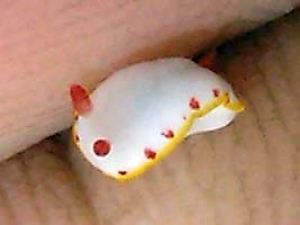
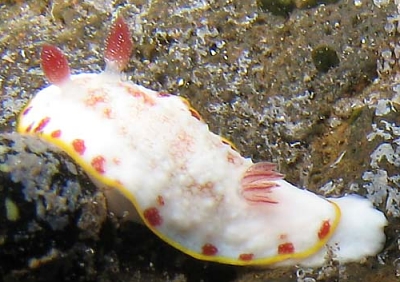
Dear Bill,
I found this species from October to January on a rocky coast. Here are three photos: Upper: 2-3 mm long. Middle: 15 mm long. Lower: 40 mm. long.
Locality: Etang Salé, 1m, Reunion Island, Indian Ocean, Rocky coast. Photographer: Philibert Bidgrain
I think that all of these specimens are Chromodoris tinctoria, showing the development of the colour pattern as the animal grows. What's your opinion about this hypothesis?
Philibert Bidgrain
http://vieoceane.free.fr/runseaslug/indexslug.htm.
pbidgrain@yahoo.fr
Bidgrain, P., 2006 (Dec 14) Colour pattern change in growth of Chromodoris tinctoria . [Message in] Sea Slug Forum. Australian Museum, Sydney. Available from http://www.seaslugforum.net/find/18942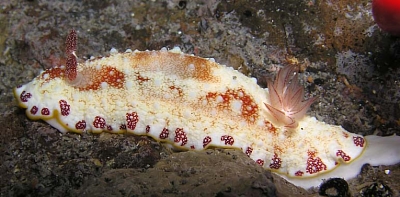
Dear Philibert,
I agree these are all C. tinctoria. Often small juveniles are difficult to identify unless you are familiar with the colour pattern of the sub adult animals. The red spots which develop into patches around the mantle edge in Indian ocean specimens are not always present in Western Pacific animals.
Best wishes,
Bill Rudman
Chromodoris tinctoria from nthn New South Wales, Australia
September 8, 2006
From: Roxanne Fea
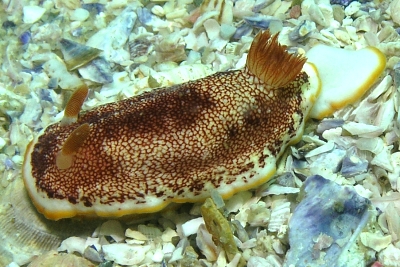
Dear Bill,
While diving at Julian Rocks last week, we found this little nudibranch at around 9m on rocky substrate. Is this a red netted chromodoris?
Locality: Julian Rocks, 9m, NSW, Tasman, 22 August 2006, Rocky substrate. Length: 10mm. Photographer: Jason Coombs.
Best wishes,
Roxanne Fea & Jason Coombs
bungysheep@hotmail.com
Fea, R.I., 2006 (Sep 8) Chromodoris tinctoria from nthn New South Wales, Australia. [Message in] Sea Slug Forum. Australian Museum, Sydney. Available from http://www.seaslugforum.net/find/17651Dear Roxanne,
This is Chromodoris tinctoria. I guess 'red-netted' chromodoris is one of Neville Coleman's common names for this species. Have a look at my Fact Sheet on 'common names' to see why I think made-up names like this are a bad thing.
Best wishes,
Bill Rudman
Re: Chromodoris tinctoria feeding
June 8, 2006
From: Bruce Wilkie
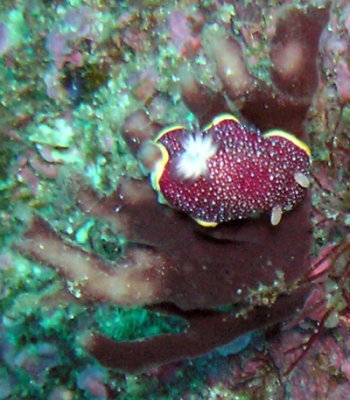
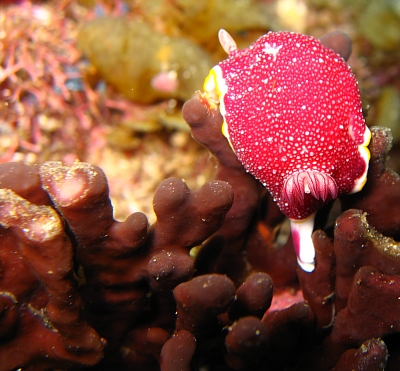
Concerning message #16786:
Hi Bill,
Better make that 4 different animals on the same type of sponge. The first photo was given to me by a friend (Jeanette Betteridge) it was also taken at Flat rock on the 3rd June 2006 in 22mts and temp 21dec. Photo`s 2 and 3 are different shots of the animals in my previous message.
Locality: Flat Rock North Stradbroke Island, 16 to 24 m, Queensland Australia, Pacific ocean, 03 June 2006, rocky reef with sponges, hard & soft corals . Length: 35 mm. Photographer: Bruce Wilkie.
Many Thanks,
Bruce Wilkie.
brucedwilkie@yahoo.com.au
Wilkie, B., 2006 (Jun 8) Re: Chromodoris tinctoria feeding. [Message in] Sea Slug Forum. Australian Museum, Sydney. Available from http://www.seaslugforum.net/find/16818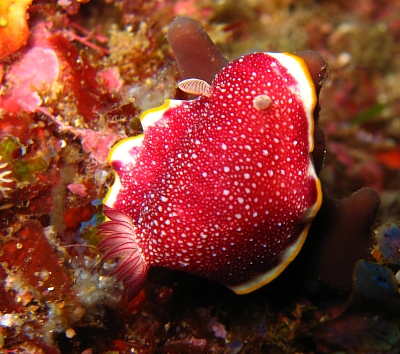
Dear Bruce,
I think we now have pretty conclusive evidence on its food. Just to be greedy, I would very much like to know what sort of egg ribbon this species produces. If there is more than one species involved in this colour group then perhaps the egg ribbon may give us some clues, although as discussed recently, it is possible for one species to have more than one type of egg development.
Best wishes,
Bill Rudman
Chromodoris tinctoria feeding
June 6, 2006
From: Bruce Wilkie
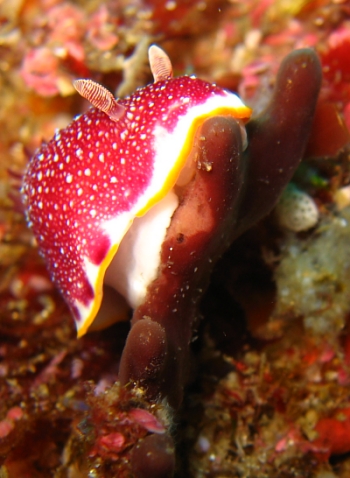
Hi Bill,
Here are photo`s of three different animals which I have id as Chromodoris tinctoria. All three are similar to the ones in Dave Harasti`s message #8248. I found these animals on the same type of sponge at three different locations around Flat rock (they all appear to be having a good munch).
Locality: Flat Rock North Stradbroke Island, 16-24 m, Queensland Australia, Pacific ocean, 29 December 2005, 24th April 2006, 3rd June 2006. rocky reef with sponges, hard & soft corals . Length: approx 35 mm. Photographer: Bruce Wilkie.
Could you please confirm these are C. tinctoria?
Many Thanks,
Bruce Wilkie.
brucedwilkie@yahoo.com.au
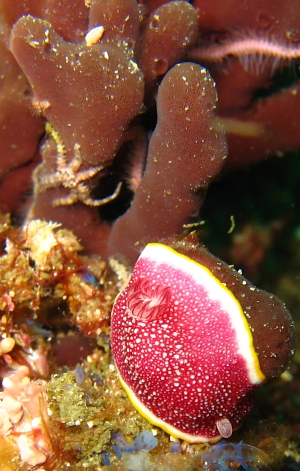
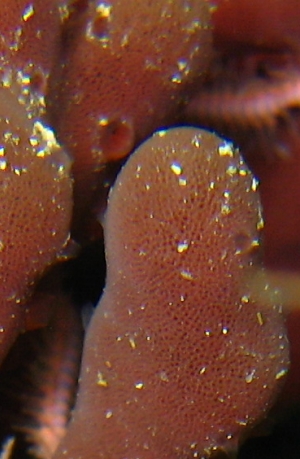
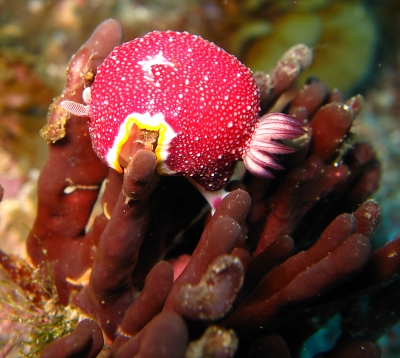
Dear Bruce,
Very interesting! Three records of this species on the same sponge, and definitely signs of damage in upper right photo. All I need to do now is confirm the sponge's identity. I have been considering this 'form' to be part of one very variable species - C. tinctoria, and their seem to be no easily distinguishable anatomical characters. However it would be valuable to learn a bit more anout this species and its various colour forms so I would welcome photos of egg ribbons and other sponges it has been found feeding on - if anyone has any.
Best wishes,
Bill Rudman
Damaged Chromodoris tinctoria
September 20, 2005
From: Chris Cunnold
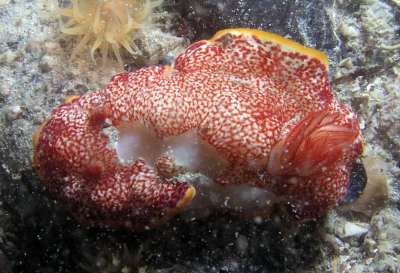
Dear Bill,
I continue to see Chromodoris tinctoria at this sight with this appearance. This is the third time I have observed multiple numbers in this deformed / injured state. Another sight about a kilometre away has plenty of healthy specimens. Do you have any idea of the cause?
Locality: Cockburn Sound, Western Australia. Depth: 6 m. 18 September 2005. Sand / Rubble. Photographer: Chris Cunnold
Chris Cunnold
cunnold@iinet.net.au
Cunnold, C., 2005 (Sep 20) Damaged Chromodoris tinctoria. [Message in] Sea Slug Forum. Australian Museum, Sydney. Available from http://www.seaslugforum.net/find/14800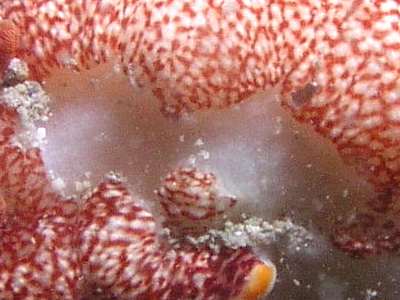
Dear Chris,
This is definitely damage rather than some genetic or developmental deformity. From the diamond-shaped nature of the wounds, it's possible some fish with a beak-like mouth - perhaps a parrot fish? - might have done this. Another possibility is a cephalopod - perhaps a territorial octopus or cuttlefish?
Best wishes,
Bill Rudman
Deformed Chromodoris tinctoria
July 9, 2003
From: Erwin Köhler
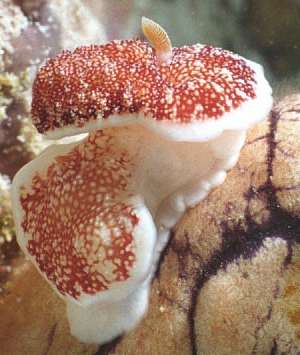
Dear Bill,
here is a Chromodoris tinctoria from Malaysia, which looks like its had contact with a ship's propeller...
The shot is by Harro H. Quitzau [Harro@Quitzau.info]
Cheers,
Erwin
Erwin@Philippine-Sea-Slugs.com
Koehler, E., 2003 (Jul 9) Deformed Chromodoris tinctoria. [Message in] Sea Slug Forum. Australian Museum, Sydney. Available from http://www.seaslugforum.net/find/10398Thanks Erwin & Harro,
It's hard to know when the damage occurred, but it certainly looks as though it has grown a new back end.
Bill Rudman
Chromodoris tinctoria - reproductive organs
June 12, 2003
From: Dong Bum Koh
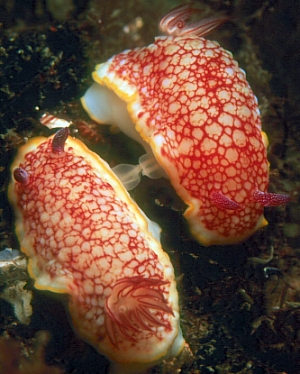
Dear Bill,
Here is Chromodoris tinctoria from Jeju island, South Korea. Chromodoris tinctoria is very common in this area but it has taken me more than 10 years experience to get this fine close-up shot of mating.
01 June 2003. in Moon islet in Jeju Sth Korea
8m depth. W/T : 19 degrees
Photographer: Dong Bum Koh
Dong Bum Koh
drkoh@seasee.co.kr
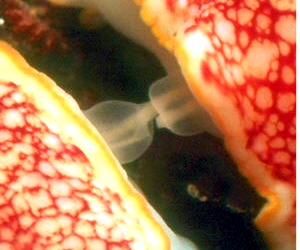
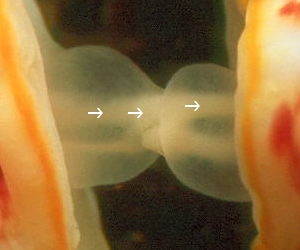
Dear Dong Bum,
Thanks for these nice photos. Since these animals can function as both male and females at the same time, I have added some arrows to one of the photos to help identify the structures. In the photo with arrows, the animal on the left of the photo has its penis inserted into the vagina of the right animal - the arrows are showing the direction of sperm transfer. The penis of the right animal, however, is only partially everted [lower duct in photo] and not inserted into the vaginal duct of its partner.
Although nudibranchs can act as both male and female simultaneously, this does not always occur. It's possible, in this example, that transfer of sperm from the right animal to the left animal may not occur, but then again it may just be that the right animal is a bit slow at getting organised.
Best wishes,
Bill Rudman
Chromodoris tinctoria - several variations
May 26, 2003
From: Julie Marshall
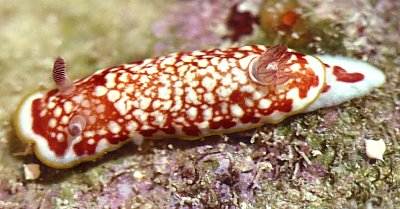
Dear Bill,
To add to the variations of this species already shown on the Forum I attach pictures of three very different examples of this species. The first very pustulose animal [lower left] was 40 mm in size and is from Lord Howe Island photographed on 27 February 2003 at 12 m. The other two pictures are from Heron Island with both animals found intertidally. Both animals were smaller (23 and 20 mm) and had a smooth mantle.
Best wishes,
Julie Marshall
juliemarshall@netspace.net.au
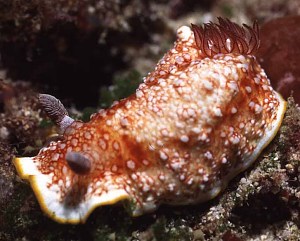
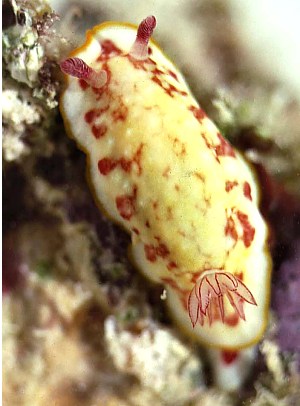
Thanks Julie,
Bill Rudman
Chromodoris from Myanmar
May 20, 2003
From: Mary Jane Adams
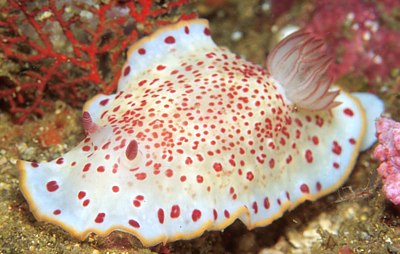
Hi Bill,
Here ia another branch from the Andaman Sea. I have never seen this one before and I can't identify it. It was crawling round on a
flat rubble bottom with patch reef between peaks of a divesite called "Three Islets" off the coast of southern Myanmar. Depth was 24 meters and the slug was about 12cm long. Date was Feb. 14, 2003.
A second one of similar size carrying two Periclimenes shrimp was seen in the same area by some other divers.
Can you ID it?
Best regads,
Mary Jane
divepng@yahoo.com
Adams, M.J., 2003 (May 20) Chromodoris from Myanmar. [Message in] Sea Slug Forum. Australian Museum, Sydney. Available from http://www.seaslugforum.net/find/9396Dear Mary Jane,
I suspect that this is Chromodoris tinctoria. I realise some of my colleagues might wish to call this a new species but I think it is probably part of a continuum of colour patterns. The red 'spots' are actually red rings, if you look carefully which certainly fits the more typical reticulate colour pattern of C. tinctoria.
Best wishes,
Bill Rudman
Chromodoris tinctoria from Myanmar
May 14, 2003
From: Mary Jane Adams
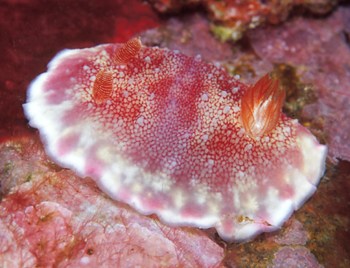
Hi Bill,
It took me a while to figure this one out, but after looking at all the variations in mantle pattern of Chromodoris tinctoria on the Sea Slug Forum, I decided that is what it is. I never would have been able to ID this slug from the single "typical" pictures that appear in
most books. Thanks for keeping up this valuable database.
Length: 18mm,
Depth: 5-10 meters,
Divesite: Black Rock, Mergui Archipelago, Andaman Sea, Myanmar.
Date: Feb. 15, 2003
Best regards,
Mary Jane
divepng@yahoo.com
Adams, M.J., 2003 (May 14) Chromodoris tinctoria from Myanmar. [Message in] Sea Slug Forum. Australian Museum, Sydney. Available from http://www.seaslugforum.net/find/9415Chromodoris tinctoria & food sponge from Egypt
January 4, 2003
From: Jason Bell
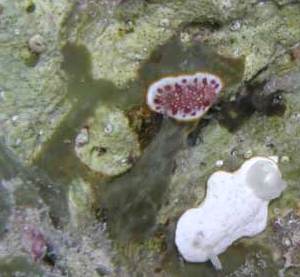
Bill,
I found these nudibranchs (approx 10mm long) on several different green sponges in Marsa Alam, Red Sea, Egypt. Using H. Debelius' field guide, The red one is Chromodoris tinctoria and I believe the white ones are C. verrieri. Can you please verify the ID.
Thanks
Jason Bell
Belljason@hotmail.com
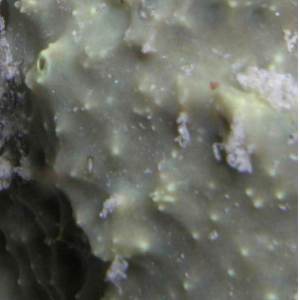
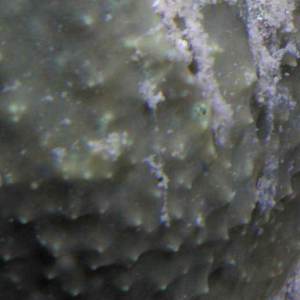
This is a copy of Jason's message on the Noumea sudanica page, which is the true identity of the white species. It appears both species are feeding on the same sponge so I have included some more closeup photos of the sponge here for cross-reference. See my comments about the sponge in the first message.
Bill Rudman
Chromodoris tinctoria from Sthn Queensland
October 23, 2002
From: David Harasti
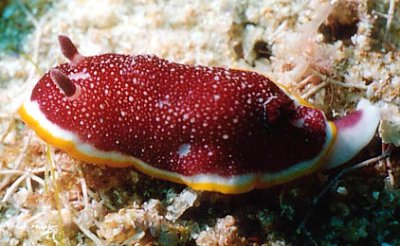
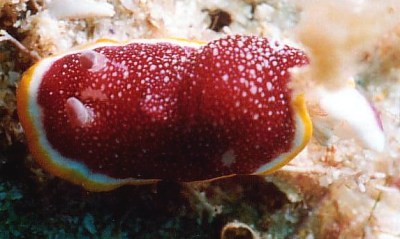
Hi Bill,
I am having difficulty in identifying this species. I believe it is a Chromodoris species, perhaps even a colour variation of C. splendida or C. daphne?
The animal was found in 15 metres water at Flinders Reef, located off Moreton Island in southern Queensland, Australia, in October 2002. The animal was about 4cm long and water temp 22 degrees.
If you could assist in the ID it would be greatly appreciated.
Regards,
David Harasti
http://www.webone.com.au/~diving
diving@webone.com.au
Harasti, D., 2002 (Oct 23) Chromodoris tinctoria from Sthn Queensland. [Message in] Sea Slug Forum. Australian Museum, Sydney. Available from http://www.seaslugforum.net/find/8248Dear David,
You were right to think it might be a colour variation of some other species as the southern Queensland - nthn New South Wales region does have some strange colour variations of both southern and northern species. In this case though your animal is the tropical species Chromodoris tinctoria which is quite variable in colour. This colour form though is found throughout the species' range. I have a photo of a similar form from Lizard Island in North Queensland on the species Fact Sheet.
Best wishes,
Bill Rudman
Chromodoris tinctoria from Malaysia
September 17, 2002
From: Richard Houghton
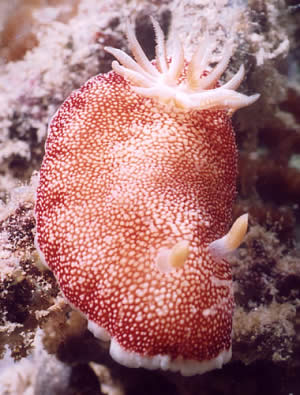
Dear Bill,
This 6cm nudibranch could be Chromodoris reticulata.
Found at the bottom of a reef slope at about 10 metres, off Kapalai Island, Malaysia in August 2002.
Rich
richard_houghton@hotmail.com
Houghton, R., 2002 (Sep 17) Chromodoris tinctoria from Malaysia. [Message in] Sea Slug Forum. Australian Museum, Sydney. Available from http://www.seaslugforum.net/find/7847Dear Rich,
C. reticulata is one of the synonyms of Chromodoris tinctoria. This colour form lacks the orange or yellow marginal band on the mantle.
Best wishes,
Bill Rudman
Chromodoris tinctoria from Malaysia
June 18, 2002
From: Kheong Sann Chan
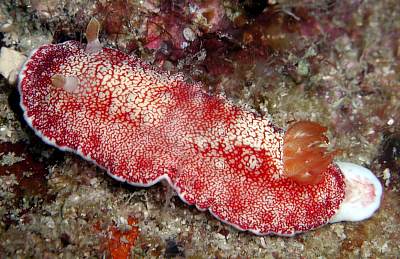
Found a Chromodoris tinctoria from Pulau Dayang off the east coast of west Malaysia. It looks pretty much like the one Mary Jane Adams got.
Location: Dayang,Dayang house reef
Date: 9 June, 0800
Depth: 8m
Kheong
kschan@mail.dsi.nus.edu.sg
Chan, K.S., 2002 (Jun 18) Chromodoris tinctoria from Malaysia. [Message in] Sea Slug Forum. Australian Museum, Sydney. Available from http://www.seaslugforum.net/find/7227Thanks Kheong,
Bill Rudman
Chromodoris tinctoria from Sulawesi
June 11, 2002
From: Mary Jane Adams
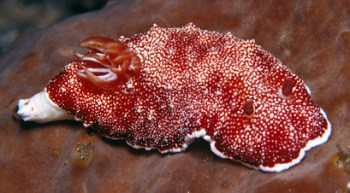
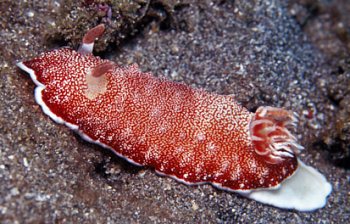
Hi Bill,
Here are two Chromodoris tinctoria specimens from Lembeh Strait, Sulawesi, Indonesia. The upper one I shot at Pante Parigi on April, 10, 2002. The lower one is from Nudi Falls on April
20, 2002. Neither one of them has a yellow mantle border, but the lower one has a couple of yellow spots on the tail end of its foot.
They were about 30-35 mm long.
Best regards,
Mary Jane
divepng@yahoo.com
Adams, M J., 2002 (Jun 11) Chromodoris tinctoria from Sulawesi. [Message in] Sea Slug Forum. Australian Museum, Sydney. Available from http://www.seaslugforum.net/find/6914Thanks Mary Jane,
This form without a yellow border was as far back as 1832 considered a a separate species Doris reticulata Quoy & Gaimard, from animals they collected in New Guinea. However we now consider this to be one quite variable species, with much of the variation scattered through the many messages on the Forum.
best wishes,
Bill Rudman
Chromodoris tinctoria from Taiwan's N.E. Coast
May 30, 2002
From: Todd Garthwaite
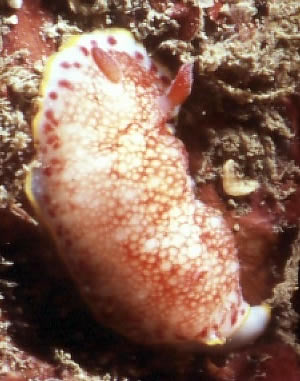
Hi Bill,
Here are two shots of what I believe to be Chromodoris tinctoria. I came across this specimen in a silty area with sponges, and small patches of soft & hard coral.
Site: "Fan-Zai Ao" (["Barbarian Cove"], N.E. Coast, Taipei County, Taiwan)
Date: 19 May 2002
Time: 10:13am
Depth: 17.9 meters
Temp: 24 degrees C.
Size: Approx. 25+ mm
Todd Garthwaite
(Taipei, Taiwan)
typhoontoddy@yahoo.com
Garthwaite, T., 2002 (May 30) Chromodoris tinctoria from Taiwan's N.E. Coast. [Message in] Sea Slug Forum. Australian Museum, Sydney. Available from http://www.seaslugforum.net/find/7041Thanks Todd,
Bill Rudman
Chromodoris tinctoria from Solomon Ids
March 10, 2002
From: Bruce Potter
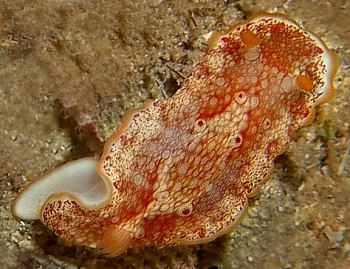
Dear Bill,
I found this Chromodoris tinctoria on a night dive on 11 February 2002. It is quite different from the ones that I normally find here. I have never seen one with the large red spots on its mantle before. It was about 24mm long. It was at about 12 meters on a coral and rubble site on the outskirts of Honiara, Solomon Islands.
Regards
Bruce Potter
bruce.potter@adventist.org.sb
Potter, B., 2002 (Mar 10) Chromodoris tinctoria from Solomon Ids. [Message in] Sea Slug Forum. Australian Museum, Sydney. Available from http://www.seaslugforum.net/find/6228Thanks Bruce,
This colour form doesn't seem to have any anatomical differences from more 'typical' specimens. This colour form does not seem to that common but has been reported from most of the Indo-West Pacific.
Best wishes,
Bill Rudman
Unknown Chromodoris from Japan
August 31, 2001
From: Nishina Masayoshi
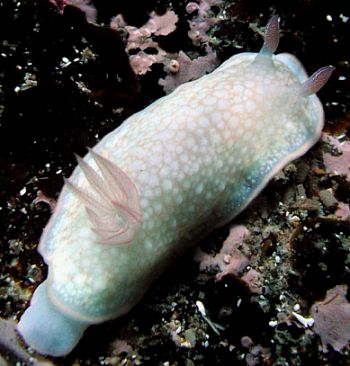
Dear Dr.Rudman,
I found this animal at Echizen, Japan where it appears to be very common at Echizen beach, but I've never seen this and could not find it in my ID book or any web site that I know.
It's looks like a Chromodoris, and from its body shape it looks like a
Chromodoris tinctoria. But this animal has pale pink rhinophores, gills and marginal band.
And color pattern on the back is not familiar for me.
Place: Echizen Beach, Japan.
Day: 17th July, 2001
Depth: 5m
Water Temp: 25C degree
Size: 30mm-40mm
Best Regards,
Nishina Masayoshi
nishina@hp15.wips.co.jp
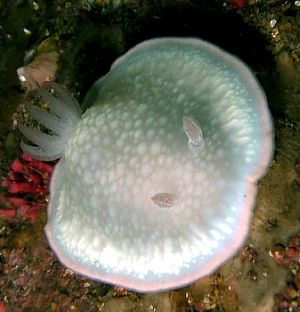

Dear Nishina,
In an earlier message you sent some photos of some pale specimens of Chromodoris tinctoria. I suspect these are even paler examples. The colour pattern fits well, but what is missing is most of the red pigmentation, leaving a pale pink pattern wherever red would normally be. And what about the yellow border? You will note in your earlier photos that the border was a very pale pinkish orange - not that different to the pink colour in these photos. We just don't know enough about pigmentation in nudibranchs to know how bright yellow pigment is produced. Perhaps it requires the same molecules as are needed to form bright red. My considered guess is that this is a peculiar colour form of C. tinctoria.
Whatever it is, thanks again for another interesting contribution.
Best wishes,
Bill Rudman.
Chromodoris tinctoria from Japan
August 30, 2001
From: Jun Imamoto
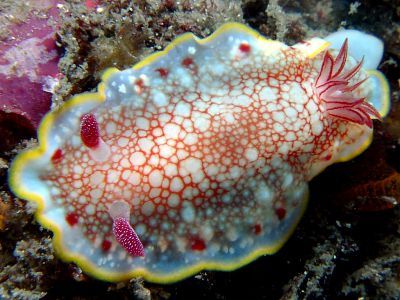
Dear Bill
Here are some photos of Chromodoris tinctoria which I filmed at Tsuruga Bay and Sagami Bay. It is a design different from the photograph which Mr. Nishina Masayoshi sent. The presence of a spotted design around the mantle edge is a characteristic.
UPPER RIGHT:
Place: Izu-Peninsula Kawana (Sagami-bay, Japan) Depth: 12m, Size: 40-45mm,
Water temperature: 17-18C degrees.
LOWER RIGHT:
Place: Echizen coast(Tsuruga-bay, Japan)
Depth: 4-5m, Size: 25-30mm,
Water temperature: 26-28C degrees.
LOWER LEFT:
Place: Echizen coast (Tsuruga-bay, Japan)
Depth: 4-5m, Size: 35-40mm,
Water temperature: 26-28C degrees.
Those are common sea slugs there, but I am happy if those are helpful for you.
Best Regards,
Jun Imamoto
imamoto@wips.co.jp
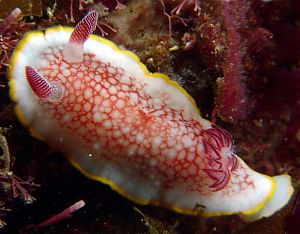
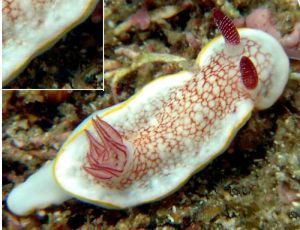
Thanks Jun,
Unless I am making a big mistake, I think C. tinctoria is a very variably coloured species. Your photos, and the photos in the various messages from Nishina Masayoshi, illustrate some of these colour variations. It would be nice to see photos of different colour forms feeding or mating together.
Best wishes,
Bill Rudman
Chromodoris tinctoria from Japan
August 9, 2001
From: Nishina Masayoshi
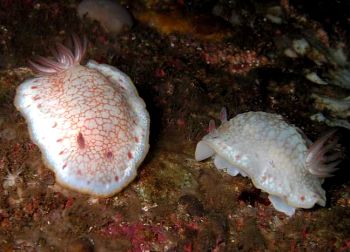
Dear Dr.Rudman,
Chromodoris tinctoria is very much common in Japan and often we are able to see that the body color changes from juvenile to adult.
I think these two are Chromodoris tinctoria although they do not have the usual colour pattern we find in Japan. I think they are already adult because of their size.
Date: 21 July, 2001
Place: Echizen Beach (West coast of Japan)
Depth: 7m
Size: 40-50mm
Best Regards,
Nishina Masayoshi
nishina@hpe15.wips.co.jp
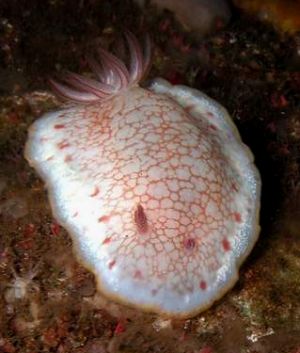
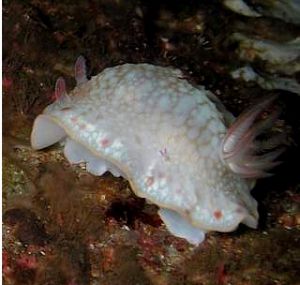
Dear Nishina,
I would agree they are a colour form of C. tinctoria which is appears to be very variable in colour. Compared with your earlier photo, these animals appear to be lacking much of the red pigment. I am interested in your comment that they appear to change colour as they grow.
Except for a very few studies, we know almost nothing about pigment in nudibranchs, whether they make it themselves or incorporate it from their food, so hopefully, examples like this might excite the interest of some chemist or graduate student looking for an ineteresting project.
Best wishes,
Bill Rudman.
Chromodoris tinctoria from Sagami Bay, Japan
August 2, 2001
From: Nishina Masayoshi
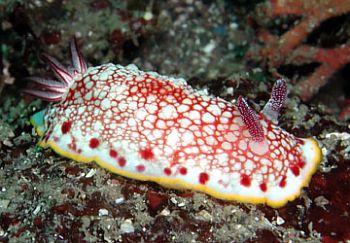
Dear Dr.Rudman,
Here is a photo of Chromodoris tinctoria that Chikako took on 7th July, 2001 at Enoura beach, Sagami Bay, Japan.
Data:
Depth:10m
Size: 50mm
Comment: Common here
Nishina Masayoshi
nishina@hpe15.wips.co.jp
Nishina, M., 2001 (Aug 2) Chromodoris tinctoria from Sagami Bay, Japan. [Message in] Sea Slug Forum. Australian Museum, Sydney. Available from http://www.seaslugforum.net/find/4938Dear Nishina & Chikako,
Thanks for this photo
Cheers,
Bill Rudman
Is this Chromodoris petechialis?
May 31, 2001
From: Bob Owens
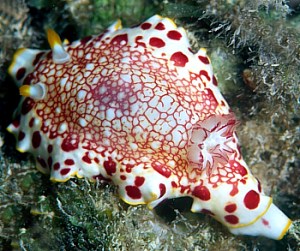
We got the copy of the message asking for possible sightings of the nudibranch C. petechialis. I have photos of a nudibranch from Midway Island which looks astonishingly like the photos on the website. The entire animal looks exactly like the one illustrated except for the entire center of the back which has a lace-like pattern of interlocking red lines, much like a gold-laced nudibranch. Towards the edges are seen the same irregular red spots, the border of yellow, the orange rhinophores, the gills are the same as those in the photo. Could this animal have interbred with another species? I have not been able to identify the species I have.
The animal was found in September 1999 in shallow water and was approx 1.5-2 inches [4-5cm] long.
Bob
bob-tinaowens@hawaii.rr.com
Owens, B., 2001 (May 31) Is this Chromodoris petechialis?. [Message in] Sea Slug Forum. Australian Museum, Sydney. Available from http://www.seaslugforum.net/find/4334Dear Bob,
Your animal is one of the colour forms of Chromodoris tinctoria. If you have a look at the other messages on this page you will see that ths species has a widespread distribution throughout the tropical Indian and Western Pacific oceans and is quite variable in colour. While the colour pattern of C. petechialis is quite similar to that of this form of C. tinctoria we know nothing of the anatomy of
I can't offer a reward for the first person to find C. petechialis again but I can promise to jump their message and photo immediately to the top of the queue on the day it arrives.
Best wishes,
Bill Rudman
Chromodoris tinctoria - abnormal rhinophore
January 19, 2001
From: Mary Jane Adams

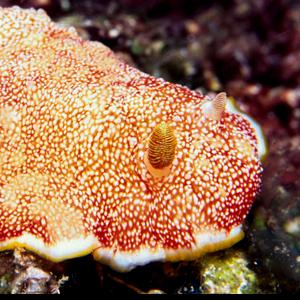
Hi Bill,
Here is a Chromodoris tinctoria I found 4 meters deep at Karumolun Island in the Russell Group [Solomon Ids]. It has a hypoplastic left rhinophore.
Best regards,
Mary Jane
divepng@yahoo.com
Adams, M.J., 2001 (Jan 19) Chromodoris tinctoria - abnormal rhinophore. [Message in] Sea Slug Forum. Australian Museum, Sydney. Available from http://www.seaslugforum.net/find/3531Dear Mary Jane,
I certainly opened a Pandora's Box when I started an Abnormalities Page. It is certainly giving us an interesting insight into what can go wrong during their development.
Bill Rudman.
Chromodoris tinctoria from Oman
November 1, 2000
From: Gordon T. Smith
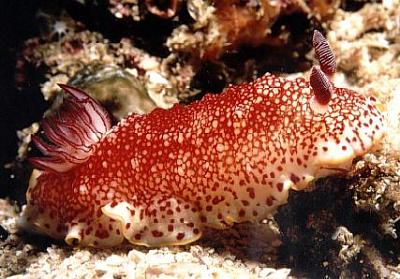
Dear Bill,
I found an example of what I believe to be Chromodoris tinctoria off Musandam Peninsula, North Oman.
I would appreciate confirmation.
Regards
Gordon T. Smith
aquashot@emirates.net.ae
Smith, G.T., 2000 (Nov 1) Chromodoris tinctoria from Oman. [Message in] Sea Slug Forum. Australian Museum, Sydney. Available from http://www.seaslugforum.net/find/3257
Dear Gordon,
Yes this is Chromodoris tinctoria. This quite variably coloured species was first described from the Red Sea, so it nice to get a photo of an animal from nearby Oman.
Out of interest I have added a photo of the original paintng from Ruppell & Leuckart's rare 1828 monograph [Plate 9 fig 4]. The red paint has discoloured considerably but you can see that the colour pattern is identical to that of your animal with a reticulate central region, then a white submarginal band with red spots, and a yellow margin.
Best wishes,
Bill Rudman.
Chromodoris reticulata?
August 24, 2000
From: Stuart Hutchison
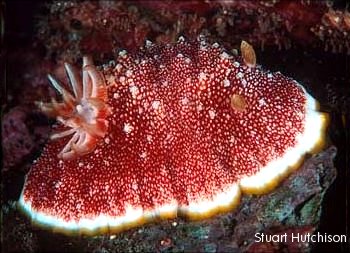
Dear Bill,
Here is a Chromodoris reticulata from the 'Lady Jewel' (Lion Island - near Lolata Island, Papua New Guinea) in March 2000. Depth 10m, size 50mm.
Regards,
Stuart
hutchco@tpg.com.au
Hutchison, S., 2000 (Aug 24) Chromodoris reticulata?. [Message in] Sea Slug Forum. Australian Museum, Sydney. Available from http://www.seaslugforum.net/find/2879Thanks Stuart,
The correct name for this species is Chromodoris tinctoria. It appears to have a number of colour forms, one without a yellow border was was named Doris reticulata by Quoy & Gaimard, 1832 and another, with a yellow border was named Goniobranchus reticulatus by Pease, 1866. As I commented in an earlier message, I think they are both colour forms of C. tinctoria
Best wishes,
Bill Rudman.
Pictures of Chromodoris reticulata
August 22, 2000
From: Udo Jansen
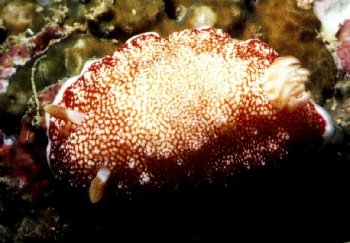
Hello my name is Udo Jansen and I visited your web pages and its fantastic to see so many different coloured sea slugs.
I have a WEB Page on Erwin Koehler's Sea Slug Web page.
There you can find many sea slug pictures and one of a Chromodoris reticulata ( Erwin said ).
size: 4 cm
depth: 20 m
date: July 28, 1999
country: Philippines
village: Sabang, Mindoro Island
divesite: Sinan Digan
I haven't found that one on your web page.
The address of my page is http://www.medslugs.de/E/Photographers/Udo_Jansen.htm
Maybe you see another interesting picture for your homepage. 3 of my pictures are already placed in your pages.
Greetings
Udo
u.jansen@planet-interkom.de
Jansen, U., 2000 (Aug 22) Pictures of Chromodoris reticulata . [Message in] Sea Slug Forum. Australian Museum, Sydney. Available from http://www.seaslugforum.net/find/2902Dear Udo,
Thanks for your interest. Sometime ago Erwin sent a message with a photo of this colour form with a white border. I explained there that it had been called D. reticulata by Quoy & Gaimard, but was now considered a colour form of Chromodoris tinctoria, which is the name it has on you website, so Erwin must have changed it.
Best wishes,
Bill Rudman.
Chromodoris reticulata? from Thailand
April 23, 2000
From: Narongpon Sittithaweepat
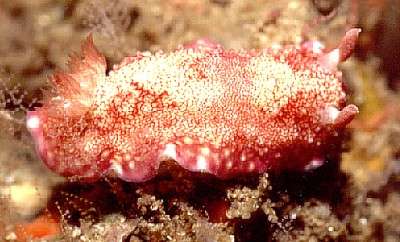
Dear Bill
I am not sure whether this specimen is Chromodoris reticulata (Pease, 1866). I found it in 60 feet at Surin Island. The photo is by Dr. Thon Thamrongnawasawat. So could you please identify it for me.
Thank you for your kindness again
Narongpon
chromodorid@thaimail.com
Sittithaweepat, N., 2000 (Apr 23) Chromodoris reticulata? from Thailand. [Message in] Sea Slug Forum. Australian Museum, Sydney. Available from http://www.seaslugforum.net/find/2211Dear Narongpon,
This is one of the colour forms of Chromodoris tinctoria. If you look at the other photos on this page you will see that this species is quite variable in colour, and many of the colour forms have been considered separate species in the past.
Best wishes,
Bill Rudman.
Chromodoris tinctoria from South Africa
March 10, 2000
From: Valda Fraser
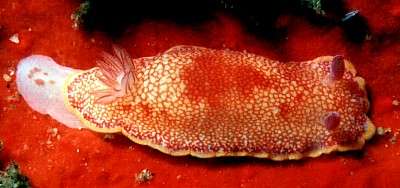
Dear Bill
Please tell me if this Chromodoris has been described. It appears in Gosliner (1987) page 78.
Locality: South Coast KwaZulu-Natal, South Africa. Hibberdene - 25m
Date: September 1999
Size: 45mm
Regards
Valda Fraser
iti04937@mweb.co.za
Fraser, V., 2000 (Mar 10) Chromodoris tinctoria from South Africa. [Message in] Sea Slug Forum. Australian Museum, Sydney. Available from http://www.seaslugforum.net/find/1947Dear Valda,
It is one of the many colour forms of Chromodoris tinctoria.
Best wishes,
Bill Rudman.
Mantle abnormality in Chromodoris
January 30, 2000
From: Mary Jane Adams
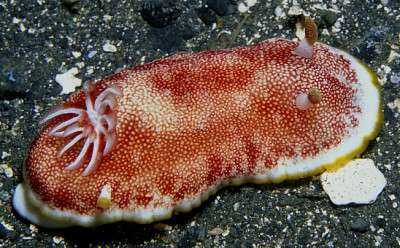
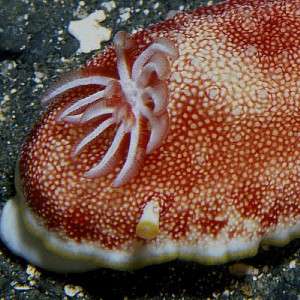
Dear Bill,
The photos of chromodorids with mantle abnormalities brought to mind one of my photo that has been puzzling me. I believe this C. tinctoria from Papua New Guinea also has an aberrant flap of mantle with border colors. Luadi, Milne Bay, 10 meters, sand slope, March 26, 1998.
Thanks for solving the mystery.
Mary Jane
mjadams@earthlink.net
Adams, M.J., 2000 (Jan 30) Mantle abnormality in Chromodoris. [Message in] Sea Slug Forum. Australian Museum, Sydney. Available from http://www.seaslugforum.net/find/1797Chromodoris tinctoria from South Africa
January 23, 2000
From: Valda Fraser

Dear Bill
I think this may be Chromodoris alderi. I'd like to know what you think.
Locality: South Coast KwaZulu-Natal SOUTH AFRICA. Shelly Beach - 32m
Date: 5 January 2000
Size: 40mm
Regards
Valda Fraser
iti04937@mweb.co.za
Fraser, V., 2000 (Jan 23) Chromodoris tinctoria from South Africa. [Message in] Sea Slug Forum. Australian Museum, Sydney. Available from http://www.seaslugforum.net/find/1736Dear Valda,
The oldest name for this species is Chromodoris tinctoria. C. alderi is an unnecessary name which I discuss above on the C. tinctoria page.
Best wishes,
Bill Rudman.
Chromodoris tinctoria from Philippines
November 3, 1999
From: Erwin Koehler
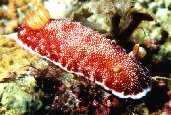
Bill,
Following your reply to Wayne, here is 'Chromodoris reticulata' (Pease, 1866), from Balicasag Is., Philippines, November 1998, 6 cm.
Erwin
Medslugs.Koehler@t-online.de
Koehler, E., 1999 (Nov 3) Chromodoris tinctoria from Philippines. [Message in] Sea Slug Forum. Australian Museum, Sydney. Available from http://www.seaslugforum.net/find/1477Dear Erwin,
It looks like your animal doesn't have a yellow border to the mantle. Pease (1866)
described a species (Goniobranchus reticulatus) from Tahiti which has a yellow-orange margin as well as a distinct white submarginal border. Quoy & Gaimard, (1832) had already named a Chromodoris from Tonga as Doris reticulata which lacked a yellow mantle margin but had a yellow margin to the foot.
I consider all to be forms of Chromodoris tinctoria.
Bill Rudman.
Chromodoris tinctoria from Lord Howe Island
October 30, 1999
From: Wayne Ellis
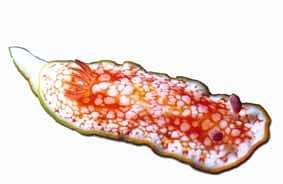
HI Bill,
Attached is an image from Lord Howe Island [off eastern Australia]. I'm not sure about. it was collected in October 1987. Is this Chromodoris tinctoria / recticulata or something else?
Wayne Ellis
glaskin@ozemail.com.au
Ellis, W., 1999 (Oct 30) Chromodoris tinctoria from Lord Howe Island. [Message in] Sea Slug Forum. Australian Museum, Sydney. Available from http://www.seaslugforum.net/find/1466Dear Wayne,
Yes this is Chromodoris tinctoria. As I try and show at the top of the page, there is quite a bit of colour variation in this species, and many of the colour varieties have been given their own names. In fact there are no distinct colour forms, rather a continuum of variation . most of the variation concerns the mantle edge. Sometimes there are red spots as in your photo, sometimes there is a distinct submarginal band, and sometimes the white is absent, the red reticulate pattern running right to the golden yellow mantle edge.
Bill Rudman.
